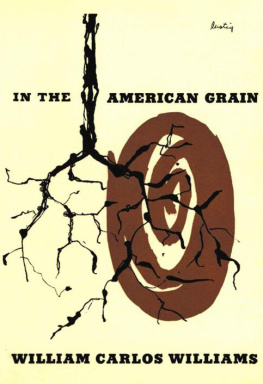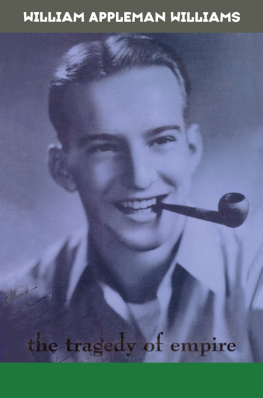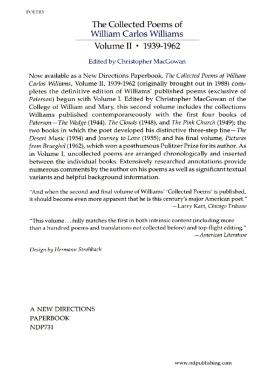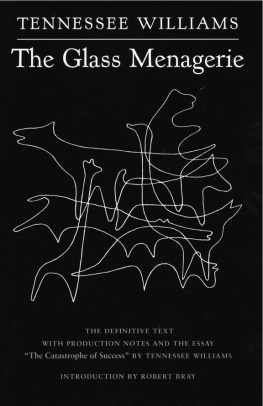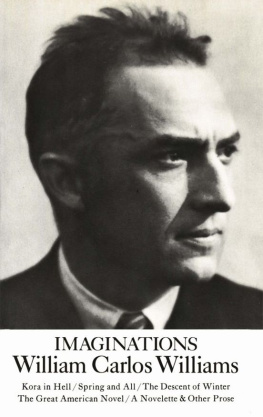William Carlos Williams [Williams - In the American Grain (Second Edition) (New Directions Paperbook)
Here you can read online William Carlos Williams [Williams - In the American Grain (Second Edition) (New Directions Paperbook) full text of the book (entire story) in english for free. Download pdf and epub, get meaning, cover and reviews about this ebook. year: 2009, publisher: New Directions, genre: Art. Description of the work, (preface) as well as reviews are available. Best literature library LitArk.com created for fans of good reading and offers a wide selection of genres:
Romance novel
Science fiction
Adventure
Detective
Science
History
Home and family
Prose
Art
Politics
Computer
Non-fiction
Religion
Business
Children
Humor
Choose a favorite category and find really read worthwhile books. Enjoy immersion in the world of imagination, feel the emotions of the characters or learn something new for yourself, make an fascinating discovery.
- Book:In the American Grain (Second Edition) (New Directions Paperbook)
- Author:
- Publisher:New Directions
- Genre:
- Year:2009
- Rating:5 / 5
- Favourites:Add to favourites
- Your mark:
- 100
- 1
- 2
- 3
- 4
- 5
In the American Grain (Second Edition) (New Directions Paperbook): summary, description and annotation
We offer to read an annotation, description, summary or preface (depends on what the author of the book "In the American Grain (Second Edition) (New Directions Paperbook)" wrote himself). If you haven't found the necessary information about the book — write in the comments, we will try to find it.
William Carlos Williams [Williams: author's other books
Who wrote In the American Grain (Second Edition) (New Directions Paperbook)? Find out the surname, the name of the author of the book and a list of all author's works by series.
In the American Grain (Second Edition) (New Directions Paperbook) — read online for free the complete book (whole text) full work
Below is the text of the book, divided by pages. System saving the place of the last page read, allows you to conveniently read the book "In the American Grain (Second Edition) (New Directions Paperbook)" online for free, without having to search again every time where you left off. Put a bookmark, and you can go to the page where you finished reading at any time.
Font size:
Interval:
Bookmark:
ESSAYS BY
WILLIAM CARLOS WILIAMS
INTRODUCTION BY
RICK MOODY
AFTERWORD BY
HORACE GREGORY

A NEW DIRECTIONS BOOK
In these studies I have sought to re-namethe things seen, now lost in chaos of borrowed titles, many of them inappropriate,under which the true character lies hid. In letters, in journals, reports ofhappenings I have recognized new contours suggested by old words so that new nameswere constituted. Thus, where I have found noteworthy stuff, bits of writing havebeen copied into the book for the taste of it. Everywhere I have tried to separateout from the original records some flavor of an actual peculiarity the characterdenoting shape which the unique force has given. Now it will be the configuration ofa man like Washington, and now a report of the witchcraft trials verbatim, a storyof a battle at seafor the odd note there is in it, a letter by Franklin toprospective emigrants; it has been my wish to draw from every source one thing, thestrange phosphorus of the life, nameless under an old misappellation.
WILLIAM CARLOS WILLIAMS
Christopher Columbus
Cortez and Montezuma
Juan Ponce de Leon
Samuel de Champlain
Thomas Morton
Daniel Boone
Benjamin Franklin
John Paul Jones
Aaron Burr
In The Autobiography of William Carlos Williams, the author gives usa few tantalizing clues about the genesis of In the American Grain. It was, Williams says, a study to try to find out formyself what the land of my more or less accidental birth might signify. A veryambitious undertaking! In a mere 250 pages! Perhaps the urgency of such a studyresults in part from Williams international origins (his father was British, andhis mother was from Puerto Rico). Perhaps Williams felt he had a unique vantagepoint on the binding myths of our North American legacy.
The plan was to try to get inside theheads of some of the American founders or heroes, if you will, by examiningtheir original records. I wanted nothing to get between me and what they themselveshad recorded...
Like the epic Paterson, therefore, the work would require a mix, sometimes acollage, of registers: of imagination, point of view, voice.
The time of composition was the teens andearly twenties of the twentieth century. Its worth noting, meanwhile, that a goodportion of the work was composed on a trip to Europe, undertaken by Williams and hiswife, Flossie, in 1922. Because of Williams demanding medical practice, theyd beenmarried ten years without a proper vacation. Before setting off, Williams workedbriefly on the manuscript in the American History room at the New York PublicLibrary, during which period the following occurred:
One day the De Soto chapter was burning inmy head. So I took out my paper, sat down at a table and, not waiting to take out abook, began to write furiously. Id been going for five or ten minutes, I guess,when the attendant, a stupid ass with a British accent, came up behind me and,tapping me on the shoulder, said I couldnt write in that room. I wasfurious.
Apparently, you absolutely had tobe researching there: So I had to get up, go out to thedesk, get out a book, put it on the table before I could go on. My day was ruined.We learn later in the same passage that Williams didnt exclusively perform thepreliminary work himself. Inthe American Grain was a teameffort: Floss did all the reading on the AaronBurr, Alexander Hamilton theme and what with her notes and what she told me, I wasso stirred that I completed the chapter at one sitting.
Later, in Europe: We did walk thereabout Villefranche; we talked, we ate, drank and played otherwise as saw fit and didconsiderable writing besides during those weeks. I finished the De Soto piecefrom In the American Grain and one or two others.It cant all be told.
Of the layout of the whole, Williamsremarks:
The Tenochtitlan chapter was written inbig, square paragraphs like Inca masonry. Raleigh was written in what I conceived tobe Elizabethan style; the Eric the Red chapter in the style of the Icelandic saga;Boone in the style of Daniels autobiography; Franklin was in Franklins words; andJohn Paul Jones I gave verbatim. Thus I tried to make each chapter not only incontent but in the style itself a close study of the theme.
Indeed, the lovely, warm plain speech ofthe later Williams, of Williams the poet and Williams the occasional prose writer,is rarely to be found in Inthe American Grain. Some ofthis may have to do with the historical moment in which these pages were composed,amid the cross-currents of high modernism, the modernism of Pound, Eliot, Woolf,Joyce, and Stein. But more likely the rationale for the competing voices has much todo with American colonial history itself. If In the American Grain amounts to the search for organic psychological,emotional, and historical certainties in the momentous discovery of the NewWorld, etc., its voices were, originally, European, coming from the violentlydisparate nations of the old continent.
Was this profusion of voices and stylesthe reason the book didnt find much of an audience upon its first publication?Williams account of publication is, for any author, such as to arouse paroxysms ofsympathy:
It was my first book by a commercialpublisher and I was dancing on airbecause to that point nothing I had written hadany market: I either paid for it myself or had it accepted, for the most part,without pay. The Bonis [his publishers] made a beautiful book of it, for which Ishall be forever grateful, but, as far as marketing it, they did next tonothing.
As a book, it fell flat. I made trip aftertrip to the publishers offices until they got so sick of seeing me that all of themwould give me a nod and walk by, talking together, and close themselves in beforeme, leaving me sitting there: a beautiful brushoff.... I had to see my high hopesof success go skittering out the window. In no time at all the thing was remainderedand I began to pick up copies wherever I could.
Its one of the great mysteries ofpublishing how some titles (Moby Dick is a fineexample) fail initially to secure an audience, but then go on to have vigorous liveslater. A writer requires a champion, an Edmund Wilson or a Tim Page, to be rescuedfrom oblivion. Although, Williams remarks, as others have, In the American Grain did, from the first, fall into the handsof some very influential readers, among them Martha Graham, Alfred Stieglitz, andHart Crane.
Still, Williams America, as depictedhere, is by no means for the faint of heart, and this may have repelled tenderersensibilities. From the initial chapter, concerning the murderous Eric the Red, wefind ourselves in a blood-dappled and unforgiving New World: Rather the ice thantheir way: to take what is mine by single strength, theirs by the crookedness oftheir law. But they have marked meeven to myself. Because I am not like them, Iam evil.
The American explorer sketched out in thischapter, in the elevated and somewhat comical imitation of an Icelandic saga, is noadmirable character (Manslaughter had driven me there), and neither are thosewho follow him in the early chapters of In the American Grain. We have Columbus, penurious, neglected by his patrons, indanger of mutiny (With its archaic smile, America found Columbus its firstvictim); Cortez, who assassinates Montezuma and destroys all that he built(only
Font size:
Interval:
Bookmark:
Similar books «In the American Grain (Second Edition) (New Directions Paperbook)»
Look at similar books to In the American Grain (Second Edition) (New Directions Paperbook). We have selected literature similar in name and meaning in the hope of providing readers with more options to find new, interesting, not yet read works.
Discussion, reviews of the book In the American Grain (Second Edition) (New Directions Paperbook) and just readers' own opinions. Leave your comments, write what you think about the work, its meaning or the main characters. Specify what exactly you liked and what you didn't like, and why you think so.

